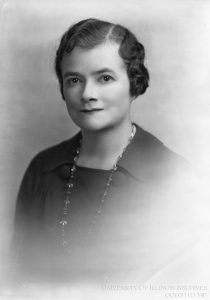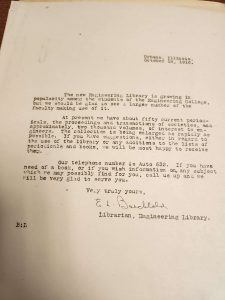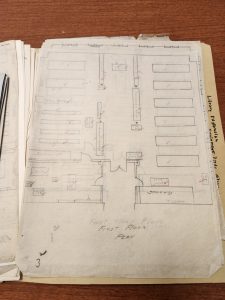By Benjamin Eskin Shapson
Who was responsible for establishing the practice of engineering librarianship at the University of Illinois Urbana-Champaign in the early 1900s? Who made institutional information resource management a model for engineering libraries across the United States? How can we understand the context they worked in, given the century that separates us? A recent initiative at the Grainger Engineering Library Information Center (GELIC) explores these questions by using resources of the University of Illinois Archives, which has helped to bring the obscured history of early engineering librarianship at the university to light. By making visible primary source records tied to this history, we can understand the efforts and accomplishments of the women who served as the first two Engineering Librarians for the university—Elsie Louise Baechtold and Hilda Josephine Alseth—and recognize the legacy of their service.

Before we can consider these two librarians, we must recognize the difference between the library services the college offered then and what it offers now. Today, GELIC is one of the most-visited buildings on campus. Boasting an experimental technology center (the IDEA Lab), a Computer-Based Testing Facility, abundant study spaces and group rooms, and a café, the GELIC is well-positioned and provisioned as a modern academic library. But the GELIC’s important presence on campus belies its recency: it only opened in 1994 under the direction of its former head, Professor Emeritus William Mischo. In the context of the University’s history, however, Baechtold and Alseth’s story begins in Engineering Hall Library.
Opened on September 20, 1916, on the first floor of the north wing of the Engineering Hall on the Bardeen Quadrangle (directly south and across the creek from the GELIC today) the General Engineering Library and Reading Room was intended to serve as a resource information center and study space for College of Engineering students. It was later renamed the Engineering Hall Library at the time of the second librarian. Its first director was Elsie Louise Baechtold, who served as its first librarian and thus as the first Engineering Librarian at the university.

Baechtold, who earned a Bachelor of Library Science degree at the University of Illinois in 1916 and had previously served as a Library Assistant during her studies, was given direction over the operations of the Engineering Library. As the sole salaried employee in the library, everything—from the establishment of the initial collection to the hiring of Library Assistants and the planning of physical renovations—was her responsibility. Her efforts were critical to the outsized success of the Engineering Library: attendance skyrocketed after the first week and remained strong throughout Baechtold’s three-year tenure.
Baechtold was a frequent advocate for increasing Library Assistant employment in the library: her concerns were primarily tied to distributing the staggering workload of being sole librarian. After Baechtold departed in 1919 to begin work in public and academic librarianship, the role of Engineering Librarian was taken over by one of these Library Assistants, Hilda Josephine Alseth, who served as the second Engineering Librarian at the University from 1919 to 1954.
Alseth, who had earned a Bachelor of Library Science degree at the university in 1919, oversaw a 35-year period of enormous expansion at the Engineering Library. The collection swelled in volume such that, by the time of her departure, the Engineering collection encompassed some 75,000 items, an impressive quantity for the time, a consequence of Alseth’s concerted collection development efforts and skills as well as its absorption of the Electrical Engineering and the Railway and Mining Engineering Libraries [1]. She was particularly adept in collecting non-English engineering publications and periodicals, especially in German. Equally important, Alseth was also a staunch advocate for the importance of generalized reading in engineering education and the incorporation of non-engineering leisure and educational literature into the lives of engineering students, publishing articles and surveys on the subject in her early career. It is an initiative the GELIC continues to champion today through its themed pop-up collections, where non-engineering items from other campus libraries are gathered at displays in the GELIC for patrons to check out, with each display being themed around a topic, such as Queer Romance or AfroFuturism, to broaden the range of literature available to the GELIC’s patrons.

The most visible of Alseth’s accomplishments was the expansion of the library in 1930 into a lecture room directly above the formerly single-floor (and largely single-room) Engineering Library. This was the most dramatic renovation and physical expansion of the library since its opening, and it helped the Engineering Library continue to grow its collection and its national prominence throughout the second half of Alseth’s tenure. The impact of the Engineering Library was also felt in less visible ways: according to annual reports in 1944, the College of Engineering was involved in several sensitive military engineering projects organized by the United States Military during World War II. As another one of her duties, Baechtold was responsible for managing and meeting the information needs of the faculty who were connected to these projects [2]. Alseth was an active participant and chairwoman of several library and engineering education professional associations, and when she retired in 1954, she had left behind a storied career as, according to then-Dean of Libraries Phineas L. Windsor, a “no.1 engineering librarian,” and as the woman who took the developing Engineering Library and made it, according to then-Professor of theoretical and applied mechanics Jasper Owen Draffin, into one capable of standing “beside any other Engineering Library in the country.” [3]

All this information, and much more concerning their professional careers and personal lives, is represented through the primary source documents produced by both Baechtold and Alseth and preserved in the University Archives. Alseth’s only attestation of her impact is a scholarship bearing her name and a mention in the Baker and King’s “History of the College of Engineering of the University of Illinois, 1868-1945” alongside Baechtold [2]. While no small recognition, these still share little about the people and the professionals that they were. A short-term exploration into the archival folders and boxes that bear their names cannot itself bring everything to light, nor can a single exhibition. The documents themselves have critical gaps (there is scant pre-1916 documentation on Baechtold, and Alseth’s second decade of librarianship, from the mid-1930s to the later 1940s, is largely invisible). Yet there is still a responsibility to at least make the attempt: the attempt to discover, to highlight, and to recognize.
GELIC owes much of its present success to the legacy of the accomplishments of these two women. It was their efforts that first opened the GELIC’s predecessor and built its collection and prestige to the point where it was regularly and widely regarded as one of the country’s pre-eminent engineering libraries, a model by which others could and should aspire to. This is reflected in the documentation that attests to Alseth’s professional prominence and the frequency with which she received questions from other libraries about how they might learn from the organization and substance of the Engineering Library. It is a reputation that is maintained today. Credit for the GELIC’s current importance can and should also be owed to the Engineering librarians who came after, and to all the staff, faculty, and graduate assistants who helped make it possible. But it remains important to recognize the two librarians who came first, and whose histories have yet to be explored more completely.
A fuller picture of the lives and institutional impact of both Elsie Louise Baechtold and Hilda Josephine Alseth is offered through the Women in the Early UIUC Engineering Library: A Women’s History Month Exhibit, currently featured on the third floor exhibit space in the Grainger Engineering Library Information Center until May 2024. This exhibition features letters, reports, photographs, floor plans, and a fold-out blueprint of the Engineering Hall Library. All patrons and members of the public are welcome to visit to learn more about these two women and their contributions to engineering librarianship at the university and beyond.
References
[1] Baker, Ira Osborn and Everett E. King. A history of the College of Engineering of the University of Illinois 1868-1945. Part II. University of Illinois Urbana-Champaign, 1947.
[2] Annual Reports, 1903-71, 1978-79, 1987-88, Record Series 11/1/3, University of Illinois Archives.
[3] Engineering Library Correspondence, Record Series 35/3/11, Box 2. University of Illinois Archives.